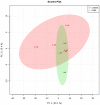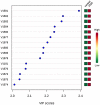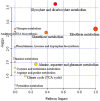Novel chloroquine loaded curcumin based anionic linear globular dendrimer G2: a metabolomics study on Plasmodium falciparum in vitro using 1H NMR spectroscopy
- PMID: 32102701
- PMCID: PMC10318260
- DOI: 10.1017/S0031182020000372
Novel chloroquine loaded curcumin based anionic linear globular dendrimer G2: a metabolomics study on Plasmodium falciparum in vitro using 1H NMR spectroscopy
Erratum in
-
[Novel chloroquine loaded curcumin based anionic linear globular dendrimer G2: a metabolomics study on Plasmodium falciparum in vitro using 1H NMR spectroscopy - CORRIGENDUM].Parasitology. 2020 Aug;147(9):1064. doi: 10.1017/S0031182020000682. Epub 2020 May 6. Parasitology. 2020. PMID: 32372738 Free PMC article. Spanish. No abstract available.
-
Novel Chloroquine Loaded Curcumin Based Anionic Linear Globular Dendrimer G2: A metabolomics study on Plasmodium falciparum in vitro using 1H NMR spectroscopy CORRIGENDUM - CORRIGENDUM.Parasitology. 2021 Nov;148(13):1715. doi: 10.1017/S0031182021000457. Epub 2021 Aug 24. Parasitology. 2021. PMID: 34425930 Free PMC article. No abstract available.
Abstract
Due to side-effects and inefficiency of the drugs used in malaria treatment, finding alternative medicine with less side-effects has attracted much attention. In this regard, in the present study, nanocomposite synthesized and its effects on the metabolites of P. falciparum were investigated. Subsequent to synthesis of nanocomposites, characterization was carried out using nuclear magnetic resonance (NMR), liquid chromatography-mass spectrometry (LC-MS), scanning electron microscopy, dynamic light scattering and Fourier-transform infrared tests. Solubility and drug release were measured and its toxicity on Vero cell was assessed using the MTT assay. The antiparasitic effect of the nanocomposite on the metabolites of P. falciparum was investigated by 1H NMR spectroscopy. Among synthesized nanocomposites, the average size of 239 nm showed suitable solubility in water as well as slow drug release. The MTT assay showed no toxicity for Vero cell lines. Concentrations of 2.5 μg mL-1 of nanocomposite eliminated 82.6% of the total parasites. The most effected metabolic cycles were glyoxylate and dicarboxylate metabolism. In this study, 1H NMR spectroscopy was used with untargeted metabolomics to study the effect of the nanocomposite on P. falciparum. Playing an essential role in understanding drug-target interactions and characterization of mechanism of action or resistance exhibited by novel antiprotozoal drugs, can be achieved by targeting metabolic using LC-MS.
Keywords: Dendrimer G2; Protozoa; malaria; metabolomic; nanocomposite.
Figures














Similar articles
-
[Novel chloroquine loaded curcumin based anionic linear globular dendrimer G2: a metabolomics study on Plasmodium falciparum in vitro using 1H NMR spectroscopy - CORRIGENDUM].Parasitology. 2020 Aug;147(9):1064. doi: 10.1017/S0031182020000682. Epub 2020 May 6. Parasitology. 2020. PMID: 32372738 Free PMC article. Spanish. No abstract available.
-
Antiplasmodial Effect of Nano Dendrimer G2 Loaded with Chloroquine in Mice Infected with Plasmodium berghei.Acta Parasitol. 2022 Mar;67(1):298-308. doi: 10.1007/s11686-021-00459-4. Epub 2021 Aug 16. Acta Parasitol. 2022. PMID: 34398379
-
Antimalarial Effects of Nano Chloroquine Loaded Curcumin In vivo.Infect Disord Drug Targets. 2024;24(8):e110324227851. doi: 10.2174/0118715265276270240222070244. Infect Disord Drug Targets. 2024. PMID: 38468520
-
[Research progress on chloroquine resistance in Plasmodium falciparum and resistance reversal agent].Zhongguo Ji Sheng Chong Xue Yu Ji Sheng Chong Bing Za Zhi. 2008 Apr;26(2):141-5. Zhongguo Ji Sheng Chong Xue Yu Ji Sheng Chong Bing Za Zhi. 2008. PMID: 24812819 Review. Chinese.
-
The mechanisms of resistance to antimalarial drugs in Plasmodium falciparum.Fundam Clin Pharmacol. 2003 Apr;17(2):147-53. doi: 10.1046/j.1472-8206.2003.00164.x. Fundam Clin Pharmacol. 2003. PMID: 12667224 Review.
Cited by
-
In Vitro Study to Evaluate the Efficacy of Ultrasonicated Ethanolic Extract of Rosmarinus officinalis and its Chitosan-Based Nanoparticles Against Eimeria tenella Oocysts of Chickens.AAPS PharmSciTech. 2022 Nov 3;23(8):295. doi: 10.1208/s12249-022-02445-z. AAPS PharmSciTech. 2022. PMID: 36329254 Free PMC article.
-
Nanomaterials as a Potential Target for Infectious Parasitic Agents.Curr Drug Deliv. 2024;21(6):828-851. doi: 10.2174/1567201820666230223085403. Curr Drug Deliv. 2024. PMID: 36815647 Review.
-
Innovative Delivery Systems Loaded with Plant Bioactive Ingredients: Formulation Approaches and Applications.Plants (Basel). 2021 Jun 18;10(6):1238. doi: 10.3390/plants10061238. Plants (Basel). 2021. PMID: 34207139 Free PMC article. Review.
-
Novel Chloroquine Loaded Curcumin Based Anionic Linear Globular Dendrimer G2: A metabolomics study on Plasmodium falciparum in vitro using 1H NMR spectroscopy CORRIGENDUM - CORRIGENDUM.Parasitology. 2021 Nov;148(13):1715. doi: 10.1017/S0031182021000457. Epub 2021 Aug 24. Parasitology. 2021. PMID: 34425930 Free PMC article. No abstract available.
-
Novel Therapeutic Delivery of Nanocurcumin in Central Nervous System Related Disorders.Nanomaterials (Basel). 2020 Dec 22;11(1):2. doi: 10.3390/nano11010002. Nanomaterials (Basel). 2020. PMID: 33374979 Free PMC article. Review.
References
-
- Alavidjeh MS, Haririan I, Khorramizadeh MR, Ghane ZZ, Ardestani MS and Namazi H (2010) Anionic linear-globular dendrimers: biocompatible hybrid materials with potential uses in nanomedicine. Journal of Materials Science. Materials in Medicine 21, 1121–1133. - PubMed
-
- Babaei E, Sadeghizadeh M, Hassan ZM, Feizi MA, Najafi F and Hashemi SM (2012) Dendrosomal curcumin significantly suppresses cancer cell proliferation in vitro and in vivo. International Immunopharmacology 12, 226–234. - PubMed
Publication types
MeSH terms
Substances
LinkOut - more resources
Full Text Sources

